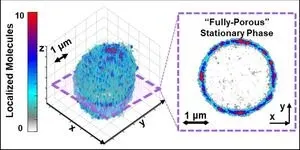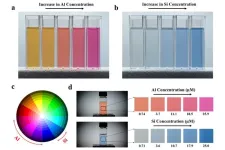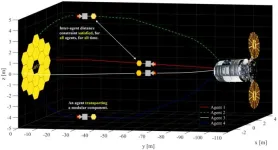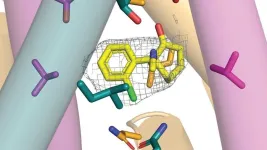(Press-News.org) CLEVELAND—The process of separating useful molecules from mixtures of other substances accounts for 15% of the nation’s energy, emits 100 million tons of carbon dioxide and costs $4 billion annually.
Commercial manufacturers produce columns of porous materials to separate potential new drugs developed by the pharmaceutical industry, for example, and also for energy and chemical production, environmental science and making foods and beverages.
But in a new study, researchers at Case Western Reserve University have found these manufactured separation materials don’t function as intended because the pores are so packed with polymer they become blocked. That means the separations are inefficient and unnecessarily expensive.
Lydia Kisley, Ambrose Swasey Assistant Professor of physics and chemistry at Case Western Reserve, used what is known as single-molecule microscopy to find that solutions containing molecules of interest mainly diffused and adsorbed around the outer edge of the porous materials, leaving the center almost entirely unused. The research will be published Feb. 14 in the journal Science Advances.
“These materials are marketed as ‘fully porous,’ but they aren’t,” said Kisley, who led the work. “We were really surprised by this. Why isn’t this material working the way it was designed and is being sold to work?”
Kisley, along with colleagues Professor Burcu Gurkan and Associate Professor Christine Duval, from the Case School of Engineering’s Department of Chemical and Biomolecular Engineering, wanted to find out why.
Single-molecule fluorescence microscopy, a specialized technique that allows scientists to visualize and analyze the behavior of individual molecules, allowed Kisley to see the molecular dynamics at the nanoscale.
“We use light to be able to observe individual molecules,” she said, “shining a bluer laser to get the molecules to fluoresce in red.”
Gurkan and a postdoctoral researcher in her lab, Muhammad Zeeshan, first tested the materials as specified by industry, not under the solution conditions they’re actually used, and found they tested as advertised by the manufacturers.
But by imaging the same materials under conditions used in actual separations, Kisley found that the manufacturers were adding so much cellulose material to capture molecules that it actually blocked the pores. Using a solvent to remove extra material improved the potential separations.
Kisley hopes their findings will help manufacturers design more efficient separations. “Half the cost of bringing a new drug to market is trying to separate molecules, a process which may be done between 10 and 20 times for one substance,” she said.
The single-molecule microscopy technique can show how separators actually work and predict their performance. If adopted by industry, this could eliminate the trial-and-error methods now used in separation science, she said.
“Maybe you could get more efficient separations and eliminate an entire step,” she said. “Think of the monetary and time savings. We could converge faster on the successful drug to help treat disease.”
Kisley cited Ricardo Monge Neria, a Case Western Reserve graduate student in physics, for leading the experimental research and writing the published paper.
Rachel Saylor, an associate professor of chemistry and biochemistry at Oberlin College, also collaborated on the study, along with researchers at the Case School of Engineering Swagelok Center for the Surface Analysis of Materials.
More information, including a copy of the paper, can be found online at the Science Advances press package at https://www.eurekalert.org/press/vancepak/.
###
At Case Western Reserve, one of the nation's leading research universities, we're driven to seek knowledge and find solutions to some of the world's most pressing problems. Nearly 6,200 undergraduate and 6,100 graduate students from across 96 countries study in our more than 250 degree programs across arts, dental medicine, engineering, law, management, medicine, nursing, science and social work. Our location in Cleveland, Ohio—a hub of cultural, business and healthcare activity—gives students unparalleled access to engaging academic, research, clinical, entrepreneurial and volunteer opportunities and prepares them to join our network of 125,000+ alumni making an impact worldwide. Visit case.edu to learn more.
END
Clearing the way for faster and more cost-effective separations
Trial-and-error separations could be replaced by quantitative and predictive molecular methods, CWRU researchers find
2025-02-14
ELSE PRESS RELEASES FROM THIS DATE:
Researchers develop a five-minute quality test for sustainable cement industry materials
2025-02-14
CHAMPAIGN, Ill. — A new test developed at the University of Illinois Urbana-Champaign can predict the performance of a new type of cementitious construction material in five minutes — a significant improvement over the current industry standard method, which takes seven or more days to complete. This development is poised to advance the use of next-generation resources called supplementary cementitious materials — or SCMs — by speeding up the quality-check process before leaving the production floor.
Due ...
Three Texas A&M professors elected to National Academy Of Engineering
2025-02-14
Drs. Vanderlei Bagnato, Rodney Bowersox and Don Lipkin from Texas A&M University’s College of Engineering have been elected to the National Academy of Engineering (NAE) Class of 2025, joining 128 new members and 22 international members. This is one of the highest professional honors for engineers.
“Congratulations to Drs. Bagnato, Bowersox and Lipkin for achieving this recognition. This prestigious honor reflects their groundbreaking contributions to engineering and underscores the exceptional talent within our faculty,” said Dr. Robert H. Bishop, vice chancellor and dean of Texas A&M ...
New research sheds light on using multiple CubeSats for in-space servicing and repair missions
2025-02-14
As more satellites, telescopes, and other spacecraft are built to be repairable, it will take reliable trajectories for service spacecraft to reach them safely. Researchers in the Department of Aerospace Engineering in The Grainger College of Engineering, University of Illinois Urbana-Champaign are developing a methodology that will allow multiple CubeSats to act as servicing agents to assemble or repair a space telescope. Their method minimizes fuel consumption, guarantees that servicing agents never come closer to each other ...
Research suggests comprehensive CT scans may help identify atherosclerosis among lung cancer patients
2025-02-14
Several cardiovascular risk factors, such as advanced age and smoking history, are prevalent among lung cancer patients at the time of the diagnosis and increase their risk of future heart disease, according to a new study being presented at ACC’s Advancing the Cardiovascular Care of the Oncology Patient course. Comprehensive assessments are needed in this vulnerable group to improve survival outcomes and quality of care for cancer patients.
Heart disease and cancer are the leading causes of death in the United States. Smoking is a shared risk factor for lung cancer and cardiovascular disease, and lung cancer patients have an amplified mortality rate with the presence of ...
Adults don’t trust health care to use AI responsibly and without harm
2025-02-14
A study finds that 65.8% of adults surveyed had low trust in their health care system to use artificial intelligence responsibly and 57.7% had low trust in their health care systems to make sure an AI tool would not harm them.
The research letter was published in JAMA Network Open.
Adults who had higher levels of overall trust in their health care systems were more likely to believe their providers would protect them from AI-related harm.
The letter, authored by Jodyn Platt, Ph.D., of the Department of Learning Health Sciences at University of Michigan Medical School and Paige Nong, Ph.D., of the University of Minnesota School of Public Health comes from survey of a nationally ...
INSEAD webinar on the dual race to AI & global leadership
2025-02-14
Digital@INSEAD is hosting a free TECH TALK X webinar “The Dual Race to AI & Global Leadership” on Wednesday, 19 February 2025 7.00 am ET / 1.00 pm CET (Duration: 60 min).
The TECH TALK will be featuring a discussion between Tim Gordon (MBA’00D), Partner, Best Practice AI and Theos Evgeniou, INSEAD Professor of Technology & Business and Director of Executive Programs in AI.
Tim, an INSEAD alumnus with over 20 years of international experience in digital transformation, global strategy and innovation, will join Theos to explore the two critical AI races reshaping our world: ...
Ketamine: From club drug to antidepressant?
2025-02-14
Ketamine has received a Hollywood makeover. It used to be known as a rave drug (street name special K) and cat anesthetic. However, in recent years, some doctors have prescribed ketamine to treat conditions from post-traumatic stress disorder to depression. “The practice is not without controversy,” notes Cold Spring Harbor Laboratory (CSHL) Professor Hiro Furukawa.
‘Should we give a hallucinogen to patients in compromised mental states?’ wonder ketamine’s skeptics. The controversy came to ...
Multilevel stressors and systemic and tumor immunity in Black and White women with breast cancer
2025-02-14
About The Study: The findings of this cross-sectional study of Black and white women with breast cancer suggest that perceived stress, perceived inadequate social support, perceived racial and ethnic discrimination, and neighborhood deprivation were associated with deleterious alterations to the systemic and tumor immune environment, particularly for Black women. Understanding biology as a possible mediator of cancer health disparities may inform prevention and public health interventions.
Corresponding Author: To contact ...
Childhood lifestyle behaviors and mental health symptoms in adolescence
2025-02-14
About The Study: This cohort study of Finnish children and adolescents found that higher physical activity and lower screen time from childhood were associated with perceived stress and depressive symptoms in adolescence. These findings emphasize reducing screen time and increasing physical activity to promote mental health in youth.
Corresponding Author: To contact the corresponding author, Eero A. Haapala, PhD, email eero.a.haapala@jyu.fi.
To access the embargoed study: Visit our For The Media website at this link https://media.jamanetwork.com/
(doi:10.1001/jamanetworkopen.2024.60012)
Editor’s Note: Please see the ...
Most comprehensive study on U.S. health care spending by county reveals wide variation
2025-02-14
At $144 billion, type 2 diabetes was the most expensive single health condition.
Emergency department care had the fastest growth.
SEATTLE, Wash., Feb. 14, 2025 – Researchers present the most comprehensive study on U.S. health care spending and variations across 3,110 counties by four payers, 148 health conditions, 38 age/sex groups, and seven types of care. That’s according to the newest and most extensive studies published in JAMA and JAMA Health Forum today.
As part of this study, researchers ...
LAST 30 PRESS RELEASES:
Researchers use robotics to find potential new antibiotic among hundreds of metal complexes
Gut bacteria changes at the earliest stages of inflammatory bowel disease
Scientists develop new way to “listen in” on the brain’s hidden language
Brain research: “Pulse generators” grow and shrink as memories are formed
For teens, any cannabis use may have impact on emotional health, academic performance
School meals could unlock major gains for human and planetary health
Menopause hormone therapy does not appear to impact dementia risk
Signature patterns of brain activity may help predict recovery from traumatic brain injury
Dresden study uncovers new key mechanism in cancer cells
New species are now being discovered faster than ever before, study suggests
Cannabis-based products show limited short-term benefit for chronic pain, with increased risk of adverse effects
Cannabis products with more THC slightly reduce pain but cause more side effects
Clearing the brain of aging cells could aid epilepsy and reduce seizures
Brain injuries linked with potential risk of suicide, new study finds
New technique lights up where drugs go in the body, cell by cell
New study finds movement of fishing fleets can reveal shifts in marine ecosystems
Embargoed: New evidence points to potential treatment for vascular dementia
Study uncovers disrupted brain balance in alcohol dependence
Working in groups can help Republicans and Democrats agree on controversial content moderation online
Structural findings reveal how distinct GPCR ligands create different levels of activation
Anything-goes “anyons” may be at the root of surprising quantum experiments
UC review: Maximizing workplace opportunity for veterans
From generation to complex control: Metasurfaces make perfect vortex beams "within reach"
Thin-film lithium niobate-based detector: recent advances and perspectives
Exploring why some people may tend to persistently make bad choices
How cells balance their protein levels
Nirsevimab vs RSVpreF vaccine for RSV–related hospitalization in newborns
Effectiveness and impact of maternal RSV immunization and nirsevimab on medically attended RSV in US children
AI gives scientists a boost, but at the cost of too many mediocre papers
Next-generation vision model maps tree growth at sub-meter precision
[Press-News.org] Clearing the way for faster and more cost-effective separationsTrial-and-error separations could be replaced by quantitative and predictive molecular methods, CWRU researchers find





